Iyon Stream Nature Reserve in the very north of the country hosts the most spectacular waterfall in Israel. Even in summer, the park is rich in riparian vegetation and the water is replete with fish.
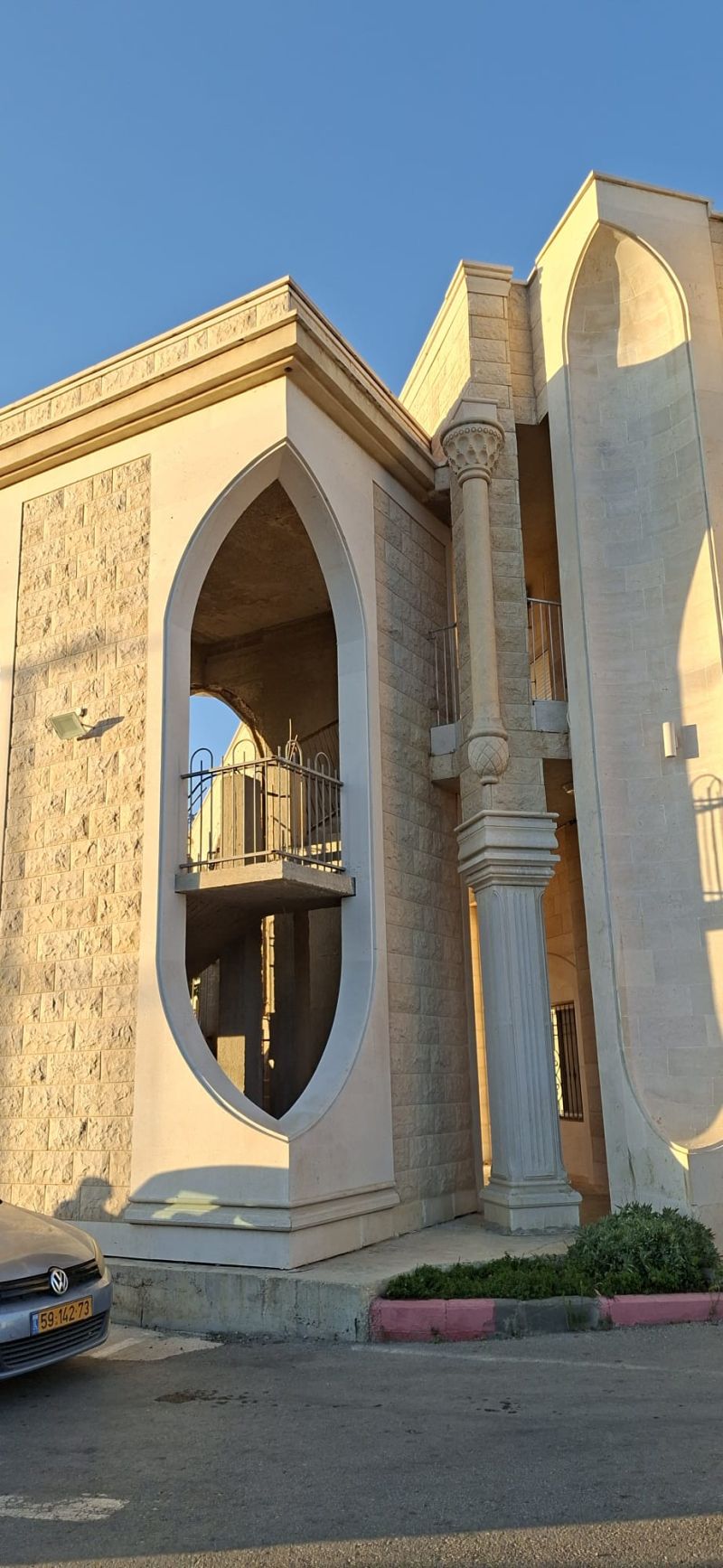
Druze Secret Religion – For the Chosen Few
Religion Underground
DRUZE SECRET RELIGION
Rolling revelation; Druze religion – historical background; Druze religion – the foundations; Druze religion – general principles; Innies and outies; Life after death; Customs, daily life; Women and the Druze religion;
At the bottom of this page there are links to all my posts on the Druze
Druze Religion - Rolling Revelation
This post about the secretive Druze religion is based on what our illustrious tour guide, Nir Keinan, told us from his personal knowledge during our visit to four Druze villages in the Lower Galilee, and on open sources from the Internet.
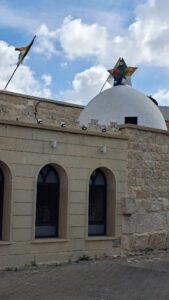 Above: Abu Arus’s tomb with a Druze 5-colored star in Yanuh-Jat. Abu Arus is one of the founders and disseminators (dawa) of the original religion in the Galilee
Above: Abu Arus’s tomb with a Druze 5-colored star in Yanuh-Jat. Abu Arus is one of the founders and disseminators (dawa) of the original religion in the Galilee
By its very definition as a secret and secretive religion, information about the Druze religion is limited, and errors and misconceptions abound. Historical sources are questionable and much hearsay and propaganda prevail.
If you find gross errors, here or in any of my other posts in this series on the Druze, please let me know in the comments section below.
The Druze believe that their religion was not born out of nothing (or out of Islam, for that matter) in the 11th century, but is a new and purified appearance of an ancient monotheistic belief, the main tenet of which is that God is one and cannot be grasped by the human mind.
Prophets, wise men, revelations and Time
Prophets of this faith showed up only rarely. Druze believe human history is divided into seven periods, and in each one a prophet and a wise man acted in tandem to transfer the secrets of the faith to the chosen few. Two such pairs were Moses and Jethro (Shu’ayeb), and Muhammad and Ali. The Druze believe that in the days of the Shi’ite Caliph, Al Hakim Be-Amr Allah (see below), the last chance was given to humanity to join the Muwahadeen, and today nobody can join it unless they were born Druze.
Druze Religion - Historical Background
Druze religion originated in Fatimid Egypt
From what we know, the Druze religion, called Tawhid, or Unity, emanated in the 11th century from a branch of Shiite Islam called Ismailism. Unlike the ubiquitous Sunna Islam, the Shi’a does allow for reforms and changes. There are more Imams waiting to appear.. Ali, Mohammad’s cousin and son-in-law was the first. Revelation is considered to be an ongoing cosmic process.
The religion was barely born, and it was already persecuted. Following the murder/disappearance of the big sponsor, Hakim bi-Amr Allah, (see below), persecution at the level of genocide was set into motion. The Muwahhiddin, as the believers called themselves, escaped northward and eventually reached Lebanon and its vicinities. A short period of proselytizing and missionary work ensued, and many tribespeople, especially from the Caucasus, joined them. After 22 years, the religion closed itself to newcomers, mixed marriages were prohibited and the Druze became a secluded insular group to this day. Their religion also went underground.
Controversial, mysterious “sponsor”
The controversial Amir, al-Hakim bi-Amr Allah,16th Fatimid Caliph and an Ismaili imam, sponsored several Shia offshoots, including the Druze. According to Nir, he brought into his palace modernistic religious sages and innovators, including Hamza Ibn Ali and Al Darazi.
Building schools and destroying churches
To know better where and how the Druze religion came into being, I searched a little about this mysterious amir. But the more I read, the less I understood. On the one hand, he showed high tolerance towards heresies and a keen interest in Greek philosophy and sciences. He even built and subsidized schools for general, secular knowledge and promoted learning and literacy.
Yet, with all that, he persecuted the “people of the book” vehemently. Jewish women were forced to wear one green and one black shoe, and Jewish men to walk publicly with a bell tied to their ankles. He destroyed Christian monasteries and churches across his empire, including the Church of Holy Sepulchre in Jerusalem.
In one sentence I read he saw himself as God; in another, that he denied it altogether and persecuted those who said that. In one paragraph I read the Druze said he was Godly, in another, that they denied this.
Murdered or risen to heaven?
The man lost his father at 8, was exiled, then re-established in the palace when court’s politics changed. His mom was said to be Christian, then not. He was called mad, “The Nero of Egypt“, or conversely, God incarnate. And then there is the question whether he was murdered or ascended to heaven, and if he was murdered ,was it his step sister who was behind it, or not?
El Darazi – saint or heretic?
The controversy and confusion continue with el Darazi, who gave the Druze their name. Our tour guide said this was a derogatory nickname, thrown the Druze way by the Sunnis, who saw in him a heretic and crook, a false prophet with pretension to personal godhood. Elsewhere, I read he bestowed godhood on al Hakim bi-amr Allah, not on himself. Either way, this is heretical in mainstream Islam, a radical monotheistic religion.
To make things even more confusing, you read that Hamza Ibn Ali, the proclaimed founder of the Druze religion and primary author of the Druze sacred, secret manuscripts, defeated Darazi following al-Hakim’s disappearance, and proclaimed that God had become human and taken the form of man, al-Hakim bi-Amr Allah.
A headache is permitted to the readers at this point, but here comes the candy:
The Jewish connection…
The name “Druze” was first mentioned in the writings of Benjamin of Tudela, the famous Jewish traveler of the 12th century, who met them in the Lebanese mountains. He recounts that the Druze and the Jews were on very good terms, and that the Druze “liked us“. Druze are described as fearless warriors, and true to form, they still are. He mentions that they believe in reincarnation and live in the mountains.
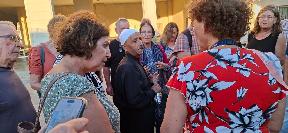 An Uqqal religious Druze explains to our group the chastity codes required at the holy site of Nebi Ya’afuri. Men had to wear long pants and women to cover their shoulders.
An Uqqal religious Druze explains to our group the chastity codes required at the holy site of Nebi Ya’afuri. Men had to wear long pants and women to cover their shoulders.
So What do We Actually Know About the Secret Druze Religion - The Foundations
Druze Religion – El Tawhid
Firstly, the name of the religion is El tawhid, meaning Unity, and it is based in the unity of God, as well as on justice, honesty, bravery and acceptance of divine creed. Yoga in the Hindu world also means “union”, perhaps with a slightly different bent. There might be a connection…
The people who follow the religion are called Bani Ma’aruf – sons of grace, or El Muwahaddun.
The Druze sacred books are called “The Letters of Wisdom” (Rasail al Jikme). They are copied in handwriting on scrolls, reminiscent of the Jewish practice of handwriting the Torah by authorized scribes. The books contain 111 letters, are organized in six tomes, and there is only one interpretation, which is also secret. Copies are kept in special safes in the Hilwes (the prayer and study houses. See below)
Syncretism
As mentioned above, the religious syncretism of Amir al-Ḥākim bi-Amr Allāh opened the doors for innovators and new voices inside the court. Hakim, who was very ascetic, was said to have made connections even with Buddhists in China, and was believed to be meditating in the hills when death, natural or not, found him.
The Druze religion, which emanated in this eclectic atmosphere, carries elements of Neoplatonism, the Wisdom cult (Sophia?), mixed in with the messages of prophets of the three monotheistic religions. Essentially, it is more of a philosophical religion, rather than a religion based in commandments like Judaism or Islam.
The Druze took on nine out of the ten commandments, discarding the Sabbath. God almighty did not need a rest day from his Creation act, hence the Druze do not have an official holy day.
Picture: Beautiful architectures ornaments the entrance to Nebi Ya’afuri’s pilgrimage site near Majdal Shams, Golan
They come in pairs – prophets and wise men
Adam, Noah, Abraham, Moses, Jesus, Muhammad and Muhammad Ibn Ismail, the founder of Ismaili Shia Islam, are the seven figures the Druze religion acknowledges as prophets. It is believed that more might come in the future in the open spirit of continued revelation of the Shi’a. In each period there was also a complementary man, who served as the “brain” and contributed the wisdom element. Jethro (Nabi Shu’ayb) served this function to Moses, John the Baptist to Jesus (Isa), and Ali to Muhammad. The Druze believe that the words of each prophet complement his predecessor, and together they form one coherent faith.
According to our tour guide, Nir Keinan, Plato (Blato in Arabic) and Socrates (Socrat) are also included in the prophets list.
A word or two on Bahai
This attitude of continued revelation is reminiscent of the Baha’i religion, another yet persecuted monotheistic religion, who found refuge in the democratic state of Israel. I personally met with Bahai devotees in New Mexico, USA, and found their religion to be an attractive model of openness, acceptance, equality, peace and a good marriage of religion with science. As can be expected from intolerant Islam, Baha’i were also badly persecuted. Like the Druze, they keep their meetings secret and private, do not missionize and maintain very low profile. Their headquarters is in Haifa.
Druze Religion - General Principles
Character building – The Guiding Principles of Conduct
The Druze religion emphasizes the general attitude a person manifests in life, his or her character. Less emphasis is put on commandments like in Judaism, or even in Islam. According to Nir, generally speaking, the community has three pillars:
Land (ard), honor (ard’) and religion (din, law).
A short personal story might be relevant in the context of honor. A very tall, religious Druze (with the round white kippa on his head) is my gas guy. He comes whenever my tank empties and carries down the new, fresh one down the 46 steps. At one point I questioned his price and immediately understood that I should not have. From his point of view, his honor was put into question, and he wanted to take off immediately and leave. It took literal begging on my part, with apologies and explanations, to get him back. Religious Druze take their oaths and their posture in life very seriously.
The cornerstones of the religion
Despite the secrecy, French scholars are said to have gotten their hands on some of the Druze Scriptures after quelling the 1925 Druze rebellion. They revealed the main principles of the religion:
Prohibition against paganism, reincarnation, the 9 Biblical commandments (Sabbath not included. God almighty did not need rest after Creation), respect to all previous prophets from Judaism, Christianity and Islam, plus 5 of their own, with Jethro in a special status, and monogamy.
The guiding principles of the Druze religion as applied to one’s life are:
The unity and singularity of God.
Justice, honesty and rightness. Chastity.
Bravery and protection of the brothers. Helping a Druze brother or sister in need.
Complete acceptance/acquiescence of divine decree for one’s fate.
Purity of tongue.
Avoiding the bad – idolatry, bad behavior, being tempted by the devil. Embracing the good.
The Five Elements
In the Druze belief there are five major elements to the Cosmos, and they feature in many other manifestations like the flag. The five Cosmic elements, if I understood correctly, but I am not real sure, are the Mind, the Soul, the Word, and Time, the past and the future. Many other systems also believe in five elements, but there might not be a connection.
God’s mind is called Hudud. The soul is part of the Cosmic soul. The elements just move to another place when the body dies.
Here in the North, the Druze flag, though not a national flag in the common use of an independent country with territory and security forces, is flown freely in Druze villages, on private houses and official buildings, as well as on cars and vans, especially on festive occasions and political protests. It has five colors:
Green – for Nature and Earth; Red – for Love, courage and heroism; Yellow – for Wheat, knowledge and enlightenment; Blue – for Water and sky, tolerance, brotherhood and forgiveness; White – For Purity, peace and conciliation.
The colors can also feature in a star form, often on top of buildings
Druze Religion - "Innies" and "Outies"
“Innies” and “outies”
I don’t know if there are other religions quite extreme in that sense like the Druze. The so-called Juhhal, lay or ignorant people, which count 90% of the population, are barely acquainted with the tenets of their own religion. They are barred from reading the Scriptures, and except for some laws of conduct, like not drinking wine and the obligation to marry within the community, they are not bound by specific rules. The actual knowledge is held by only 10% of the population, called the Uqqal, the Wisdom people. Even within that group there are levels and stages, reminiscent of the hierarchy of the Free Masons, or even of the compartmentalization typical of secretive intelligence organizations. l assume that extra caution stems from the fear of persecution by the dominant aggressive religions surrounding them.
Only Uqqal go to the Hilwes, or gathering places, to discuss the secrets of the religion and pray. And only Uqqal pilgrimage to the four out of five sacred shrines of the Druze religion in Israel. The masses congregate only on the feast of Al Shu’ayb (Jethro) near Tiberias. Even then, the first out of four days of festivities is dedicated to the Uqqal exclusively, and only by the second day the general public joins and feasts.
Boys and girls 15 of age and up can join the Uqqal, and are encouraged to do so, but there is a trial period.
Religious men tend to choose practical professions like agriculture, crafts, small commerce, as they must keep “clean tongue”. Professions like politics or law might bring about lying and deception.
A soldiers who killed a human being during his army service is barred from becoming a religious man. Same for fornication.Yet, a soldier who died in battle is elevated automatically in the religious hierarchy following his death.
The Hilwe
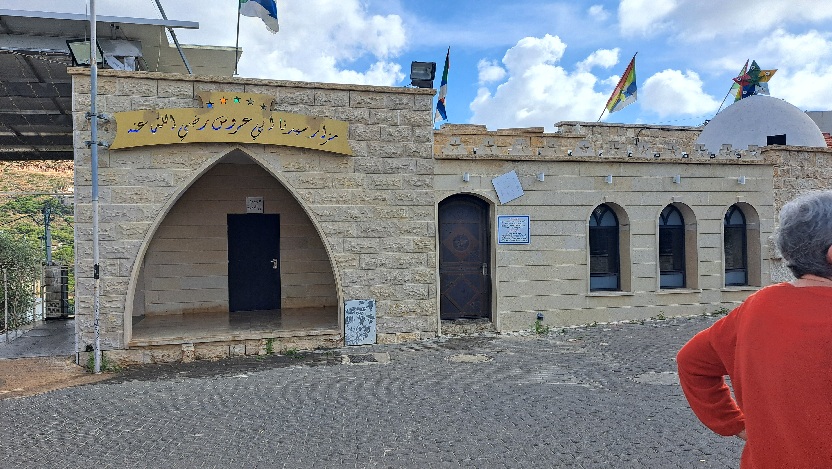 The Hilwe and tomb of Abu Arus in Yanuh-Jat. The five-colored flag and the 5-colored star are clearly visible.
The Hilwe and tomb of Abu Arus in Yanuh-Jat. The five-colored flag and the 5-colored star are clearly visible.
The Hilwe is a religious gathering place, where the Uqqal pray, study and perform rituals and ceremonies.It is a manifestation of the principle of simplicity. There are no bells and no minarets. There is only one room with a partition between men and women. On the wall, the word “Allah” might be written and sometime a picture of Amin Tarif or perhaps his grandchild. The holy scriptures are placed in a fixed safe in each Hilwe. In all, I find it has much similarity with a synagogue, and much less with a church or a mosque.
To attract the young to the religion, there is yet a third religious status – Shura, which permits joining the prayers, but not fully. When secrets are discussed, the boy or girl are sent home.
The Hilwes open Sunday and Thursday afternoons.
Education
In Yarka there is a religious school with full, organized study tracks and a dormitory. There is also one in Hilwet al Biad in Lebanon. In Nabi Shu’ayb pilgrimage sacred site there is a religious summer school.
Druze Religion - Life After Bodily Death
Reincarnation – a Druze soul stays in the Druze community
Reincarnation – the Druze believe that the body is like a camise (a shirt). You wear it and then discard it. The minute you die, you are reborn in a new baby’s body. But this applies, interestingly, only to Druze.The Druze being a closed group, with no getting out and no moving in, according to the belief, they incarnate with each other exclusively. I am not clear how they see reincarnation work for the rest of humanity.
The Druze lore is full of fascinating stories of Israeli babies finding their former families in Syria, and vice versa. An officer, Ibelieve our guide said that his name was Snir, gets during his service to the Shuff mountains in Lebanon, identifies his former house and remembers the names of the family members. Somebody was murdered there, and was immediately born in Israel. He met his former “wife” there….
In another story, a girl of three was bothering her mom with questions about her “palace”. It was found out she was the reincarnation of Nazira Jumbalat, who died on the day she was born, and they are now relatives in all senses of the word.
In another story, a boy knew where he hid his pistol in a former incarnation.
Nasiba from Buq’ata (see my post, “Druze Women Juggling Tradition and Moderna”) told us a story of a boy born speaking English, talking about the Big Ben and Princess Diana. Following a car accident in England, he opened his eyes anew in a village in the Golan.
The belief in reincarnation accounts for the bravery in battle, due to lack of fear of death, and for the non-existent burial customs I talk about in the post. “Druze Cemeteries – State, Religion and the Soul”…
Mourning and the passing of life
On mourning and cemeteries – see the above mentioned post
Druze Religion - Customs. Daily Life
Customs and rules
Again, if I misunderstood something, or omitted something important, I’ll be glad to see your comments below.
So, to the best of my understanding these are the rules:
The 9 commandments
No alcohol, pork, smoking. or drugs.
No extroverted behavior, (I’m afraid this is not what we see in their driving, but that’s a separate topic…).
Keeping women’s and family’s honor.
Generosity and hospitality.
Festivities
In principle there are none. No festivities. In reality, the Druze celebrate Eid al Adha (The Festival of the Sacrifice) and pilgrimage to prophet and founders tombs, especially to Nabi Shuʿayb (Jethro) near Tiberias, The pilgrimages to the other tombs are made only by the uqqal, the religious wise. The lay people (Juhhal) enjoy only these two holidays.
There are two versions for the Eid al Adha celebration. In principle, Druze do not follow Islamic customs. They don’t fast on Ramadan, don’t pray five times a day and don’t go on the Haj to Mecca. They apparently started to celebrate Eid al Adha in places where they lived among Muslims and did not want to estrange them or stand out and be targeted as infidels. This tallies with the custom of “taqiyya” – the duty of concealing religion in times of crisis, of pretending to be what you are not when your life is under threat.
But according to Nir, in Israel, they celebrate al-Adha because the Israeli government forced them to pick a holiday, like any other minority. In Israel, the Druze were recognized as a religious group in their own right, a status not achieved in any other country they reside in. Since by law all minorities must have a festival, they chose Eid al-Adha, which unlike Eid Al Fitr, is not associated with Ramadan.
As mentioned above, Druze do not have an official rest day. Creation is ongoing and God does not need rest.
Pilgrimage sites
Nir said that the Druze holy places are Jerusalem, Cairo and Mount Asir in Yemen (?). I did not find any independent verification of that.
Pilgrimage sites to founders/prophets tombs
Pilgrimage, or “blessed” sites, are visited almost exclusively by the uqqal. Most of them are located within the current Israeli borders. Apart from Nabi Shu’ayb, they include the tomb of prophet Sablan near Hurfeish, of the founder El-Hader in Kfar Yasif near Akko, where supposedly the prophet Elijah reincarnated as a Druze prophet. El Ya’afuri’s blessed site is located in the apple orchards between Mas’adeh and Majdal Shams in the Golan (see pictures and story in my post “Druze Women Juggling Tradition and Moderna“, and Abu Ibrahim’s tomb is in Dalyat el Carmel.
Dress
Nir explained to us the various nuances of the dress code, but I admit I did not get it. Reading about it was not helpful either. On the streets you do see women dressed in blue dresses or black. The Druze religious men in the villages and elsewhere have the white knit kippas on their heads, but according to the Wikipedia website, their dress code is highly elaborate. The principles of chastity, homogeneity and non-exposure of body contours and skin are behind the traditional attires. There is also a whole etiquette regarding mustaches and beards. I am not sure I understood who is eligible to what, but the whole world witnessed the humiliation of religious Druze men in Syria by the Bedouin mobs and regime “soldiers”, who shaved them forcefully (Check my post: “Druze Crisis in Syria – Horrors, Analysis and What Next”.
The sheikhs and other prominent figures have higher and rounder headdresses.
The young seem to dress more modern for the most part.
Colors for traditional dresses are black and blue.
Druze Women and the Religion
This topic was found to be big enough to devote a separate post to it, so the reader is referred to my post “Druze Women Juggling Tradition and Moderna”, where I also relate to women’s participation in the religion.
Devout Druze women having a mangal (BBQ) by Nebi Yafuri’s sacred sits
Druze, Israel’s Quiet Allies – History, Current Events, Women, Religion and More
In this post series I attempt to cover several topics pertaining to this fascinating and little-known religious group and ethnic minority in Israel, now on the top of world’s news. Here you can scroll through the topics according to your interest:
Under the Oak Tree in Yanuh-Jat – Intro the the Druze; Israel’s Mountain Allies and Tactics of Survival; Druze Crisis in Syria – Horrors, Analysis and What Next; Druze Secret Religion – for the Chosen Few; Druze Cemeteries – State, Religion and the Soul; Yarka and Julis – Two Quaint Galilean Druze Villages; Druze Women Juggling Tradition and Moderna.
If you like what you see and you want more,
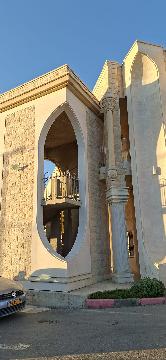
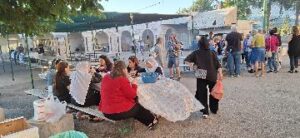




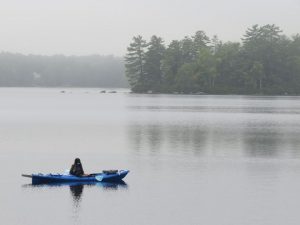




This Post Has 0 Comments